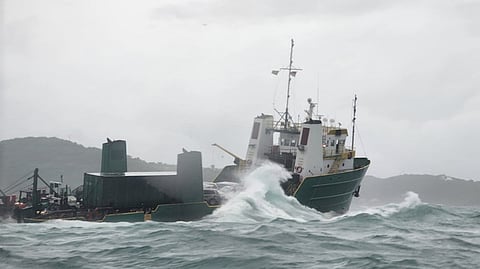Anchor chain failure led to cargo ship grounding in Caribbean, NTSB report finds
An anchor chain failure led to the grounding of a cargo vessel in the Caribbean Sea on October 4, 2023, the National Transportation Safety Board (NTSB) said earlier this week.
On the said date, the Ro-Ro vessel Bonnie G was anchored, waiting out poor weather about one mile (1.6 kilometres) south of St Thomas, US Virgin Islands, when its anchor chain parted and the vessel began to drift toward land.
As the captain attempted to navigate the vessel away from shore, the vessel grounded. The 12 people on board abandoned the vessel and were rescued by the US Coast Guard.
Bonnie G remained aground for several weeks until salvors could refloat it and tow it to a dock. No injuries or pollution were reported, though the vessel was declared a total constructive loss, valued at US$1.5 million.
Before departing St Croix, the captain of Bonnie G reviewed the weather forecast for the vessel’s intended route to St Thomas. The winds were forecasted to be between 10 and 15 knots and gusting to 25 knots after midnight, by which time the crew expected to be tied up to the dock.
When the vessel arrived in Crown Bay, the winds were higher than what had been forecasted. In addition, a loaded barge had broken free of its moorings and was partially blocking Bonnie G’s mooring location.
Given the barge blocking Bonnie G’s docking location and the worse than expected weather conditions, the captain decided to anchor the vessel until the weather improved.
Once in position within the anchorage, the captain deployed 135 feet (41.1 metres) of anchor chain, which was likely based on an erroneous assessment of the water depth being 23 to 26 feet (seven to 7.9 metres) when it was actually 68 feet (21 metres).
Investigators found that Bonnie G should have let out about 2.5 to 3.5 times more chain than was deployed. Considering the water depth and windy conditions, the captain did not let out enough chain for a secure anchorage.
“When anchoring a vessel, a length of anchor chain that is five to seven times the water depth (scope, or ratio of anchor chain to water depth) should be used; even more anchor chain should be used in adverse weather,” the report said.
The captain also did not use the available onboard navigational chart to identify a rock nearby, and when manoeuvring after the anchor chain failed, he inadvertently steered directly onto the rock and grounded the vessel. As a result, the hull was breached just forward of the engine room.
The forward watertight door in the engine room was open and not secured before the crew abandoned the vessel. Investigators determined that had the watertight door been shut as required, it is likely that progressive flooding of the engine room and aft spaces would not have occurred, limiting vessel damage.
The NTSB determined the probable cause of the grounding was the inadequate scope of chain deployed when anchoring, which likely led to the anchor chain parting, and the captain not identifying a charted rock and steering the vessel onto it when attempting to manoeuvre to safe water.
“When anchoring, mariners should review navigational charts and other sources of local information, such as the US Coast Pilot, to become familiar with nearby hazards,” the report said. “It is important to have this information available in heavy weather conditions, when there is heightened risk of drifting and crews may need to get a vessel underway on short notice.”
Marine Investigation Report 25-03 is available online.


